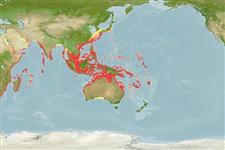Actinopterygii (ray-finned fishes) >
Perciformes (Perch-likes) >
Serranidae (Sea basses: groupers and fairy basslets) > Epinephelinae
Etymology: Epinephelus: Greek, epinephelos = cloudy (Ref. 45335).
Environment / Climate / Range
Ecology
Marine; brackish; reef-associated; depth range 1 - 100 m (Ref. 167). Subtropical, preferred 28°C (Ref. 107945); 37°N - 34°S, 28°E - 180°E (Ref. 5222)
Indo-West Pacific: Red Sea south to at least Durban, South Africa and eastward to Palau and Fiji, north to the Ryukyu Islands, south to the Arafura Sea (Ref. 9819) and Australia. Recently reported from the Mediterranean coast of Israel (Ref. 5222). Frequently misidentified as Epinephelus tauvina or Epinephelus malabaricus (Ref. 27362).
Length at first maturity / Size / Weight / Age
Maturity: Lm 48.3, range 25 - 30 cm
Max length : 120 cm TL male/unsexed; (Ref. 47613); max. published weight: 15.0 kg (Ref. 11228); max. reported age: 22 years (Ref. 3627)
Dorsal
spines
(total): 11;
Dorsal
soft rays
(total): 13-16;
Anal
spines: 3;
Anal
soft rays: 8. Small individuals closely resemble E. tauvinaand E. malabaricus, but have orange spots and lack hexagonal spots on the fins (Ref. 37816); head and body tan dorsally, shading to whitish ventrally; numerous small brownish orange or reddish brown spots on head, body and median fins (Ref. 89707); further characterized by having overall tan color; four irregular H-shaped dark bars; back with 3-4 blackish saddles; head, body and fins with numerous small brownish orange or reddish brown spots; body scales ctenoid except for nape, back, thorax, abdomen and above anal-fin base with cycloid scales; greatest depth of body 2.9-3.7 in SL; rounded caudal fin; short pelvic fins, 1.9-2.7 in head length (Ref. 90102).
Inhabit turbid coastal reefs (Ref. 9710) and are often found in brackish water (Ref. 27362) over mud and rubble (Ref. 6390). Solitary (Ref 90102). Juveniles are common in shallow waters of estuaries over sand, mud and gravel and among mangroves (Ref. 6390). Feed on small fishes, shrimps, and crabs. Probably spawn during restricted periods and form aggregations when doing so (Ref. 27352). Eggs and early larvae are probably pelagic (Ref. 6390). Has been tested in several countries as a potential species for mariculture (Ref. 43448).
Pelagic spawner (Ref. 32184).
Heemstra, P.C. and J.E. Randall, 1993. FAO Species Catalogue. Vol. 16. Groupers of the world (family Serranidae, subfamily Epinephelinae). An annotated and illustrated catalogue of the grouper, rockcod, hind, coral grouper and lyretail species known to date. Rome: FAO. FAO Fish. Synop. 125(16):382 p. (Ref. 5222)
IUCN Red List Status (Ref. 115185)
CITES (Ref. 94142)
Not Evaluated
Threat to humans
Harmless
Human uses
Fisheries: commercial; aquaculture: commercial
More information
ReferencesAquacultureAquaculture profileStrainsGeneticsAllele frequenciesHeritabilityDiseasesProcessingMass conversion
Tools
Special reports
Download XML
Internet sources
Estimates of some properties based on models
Phylogenetic diversity index (Ref.
82805): PD
50 = 0.5000 [Uniqueness, from 0.5 = low to 2.0 = high].
Bayesian length-weight: a=0.01148 (0.00996 - 0.01324), b=3.05 (3.02 - 3.08), in cm Total Length, based on LWR estimates for this species (Ref.
93245).
Trophic Level (Ref.
69278): 4.0 ±0.0 se; Based on diet studies.
Resilience (Ref.
69278): Low, minimum population doubling time 4.5 - 14 years (K=0.17; tm=2-3; tmax=22; Fec=43,618).
Prior r = 0.43, 2 SD range = 0.24 - 0.78, log(r) = -0.84, SD log(r) = 0.29, Based on: 1 M, 2 K, 3 tgen, 1 tmax, 2 Fec records
Vulnerability (Ref.
59153): High vulnerability (58 of 100) .
